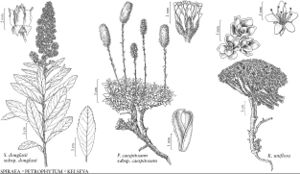Petrophytum
Mem. New York Bot. Gard. 1: 206. 1900.
| Taxon | Illustrator ⠉ | |
|---|---|---|
 | Spiraea douglasii var. douglasii Petrophytum caespitosum subsp. caespitosum Kelseya uniflora | Marjorie C. Leggitt Marjorie C. Leggitt Marjorie C. Leggitt |
Shrubs, cespitose, densely matted, 0.1–10 dm. Stems 1+, prostrate, decumbent, erect, or ascending; bark brown to dark-brown, aging to gray; short and long-shoots present; short-shoots glabrous. Leaves persistent, marcescent, cauline (tightly clustered), alternate, simple; petiole absent; blade oblanceolate to narrowly obtrullate, 0.2–2.5 (–3) cm, coriaceous, margins flat, entire, venation indistinct, masked by hairs, or palmately 1–3-veined, surfaces glabrate, strigose, canescent, pilose, or sericeous. Inflorescences terminal, 10–100-flowered, panicles narrow or widely branched, flowers aggregated, dense, compact, puberulent, canescent to sericeous; bracts present, sometimes absent; bracteoles present. Pedicels present. Flowers 2–6 mm diam.; epicalyx bractlets 0; hypanthium hemispheric, turbinate, 0.5–1 mm, canescent, pilose, or sericeous, sometimes glandular; sepals 5, erect or reflexed, ovate to lanceolate; petals 5, persistent, withering, white, oval to oblong, obovate, or oblanceolate; stamens 20–40, equal to or longer than petals; torus thickened basally, margins crenulate or entire; carpels (3–) 5 (–6) [–7], abaxially or adaxially connate or free, hirsute to pilose adaxially, styles terminal, stigmas minute; ovules 2 or 3 [or 4]. Fruits aggregated follicles, (3–) 5 (–6), lanceoloid, 1.5–2 mm, coriaceous, glabrous, glabrate, or sparsely pilose, dehiscent along abaxial and adaxial sutures; hypanthium persistent; sepals persistent, erect to reflexed; styles deciduous or persistent. Seeds 1 or 2, fusiform to terete. x = 9.
Distribution
w, sc United States, ne Mexico
Discussion
Species 3 (3 in the flora).
Taxa of Petrophytum are widely distributed in the mountains of western United States and northeastern Mexico, with P. caespitosum subsp. caespitosum the most widely distributed. The three other taxa recognized in this treatment, P. caespitosum subsp. acuminatum, P. cinerascens, and P. hendersonii, are isolated endemics with small ranges. With a single widely distributed taxon and three local endemics, it seems probable that taxa with closer geographical proximity would be likely to have greater morphological similarity. When C. Sterling (1966) examined carpel morphology in P. caespitosum, P. cinerascens, P. elatius [= P. caespitosum subsp. caespitosum], and P. hendersonii, he found that P. elatius and P. hendersonii had similar distributions of character states in five anatomical characters, yet differed as to whether carpels were fused (P. hendersonii) by their ventral bundles or distinct (P. elatius); P. caespitosum and P. cinerascens differed in only one character: carpels ventrally fused in P. caespitosum and distinct in P. cinerascens. Such incongruence of character states is seen also in leaves, flowers, and seeds; it is complicated by the reduction of these plants.
In molecular phylogenetic analyses of Rosaceae (D. Potter et al. 2007), Petrophytum was sister to Kelseya, with Spiraea basal to the pair. In a more detailed study of Spiraeeae (Potter el al. 2007b), Kelseya was sister to Petrophytum and Spiraea; however, the three topologies were not well supported and additional work may show Kelseya and Petrophytum to be sister taxa.
Selected References
None.
Key
| 1 | Pedicel bracteoles rarely extending to base of sepals; leaf abaxial surfaces glabrate, sparsely strigose, pilose to pilose-sericeous on lamina, sparsely strigose along veins, venation visible through hairs (palmately 3-veined). | Petrophytum hendersonii |
| 1 | Pedicel bracteoles extending from middle to beyond apex of sepals; leaf abaxial surfaces minutely canescent to strigose, cinereous, or pilose to sericeous, venation usually not visible through hairs [3 veins may be visible through hairs (P. cinerascens) or 3+ veins may be visible in long shoot leaves (some plants of P. caespitosum)] | > 2 |
| 2 | Pedicel bracteoles extending from middle to apex of sepals, rarely beyond; leaf blades: apices obtuse, abaxial surfaces minutely canescent to strigose or cinereous, venation sometimes visible through hairs, palmately 3-veined; petal apices acute or rounded. | Petrophytum cinerascens |
| 2 | Pedicel bracteoles usually extending well beyond apex of sepals; leaf blades: apices acute, abaxial surfaces pilose to sericeous or sparsely strigose, venation rarely visible except on long-shoot leaves, 1(–3+)-veined; petal apices obtuse to slightly cleft or acute to acuminate. | Petrophytum caespitosum |
"thin" is not a number.